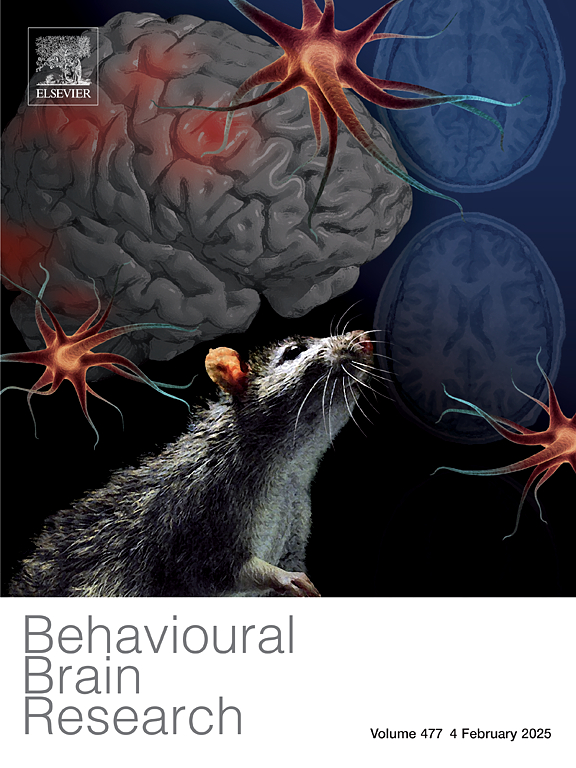Evaluating alpha-synuclein proteinopathy and consequences for birdsong in zebra finch basal ganglia area X
IF 2.6
3区 心理学
Q2 BEHAVIORAL SCIENCES
引用次数: 0
Abstract
Lewy body pathology is a major hallmark of Parkinson’s Disease (PD) and other dementias. The process of Lewy body formation is largely driven by the aggregation of alpha-synuclein (αsyn), an abundant presynaptic chaperone protein that has been shown to propagate between neurons when misfolded. Preclinical animal models inducing αsyn aggregation in the brain have demonstrated a range of behavioral consequences, though studies connecting behavioral changes to specific features of pathology are lacking. Considering vocal impairment manifests early in individuals with PD and fails to resolve upon dopamine replacement, we examined the effect of αsyn proteinopathy on birdsong in adult male zebra finches to investigate these early mechanisms of PD-related vocal dysfunction. In this study, we describe a novel tool for measuring αsyn expression called the Border Expression Ratio (BER) based on the discrete physiological distribution of αsyn surrounding basal ganglia song center, Area X. Following overexpression of human αsyn in Area X using bilateral injections of adeno-associated virus, we show that BER can be used to measure regional αsyn proteinopathy, revealing a positive correlation between right hemisphere pathology and a reduction in the variation of harmonic syllable duration. Finally, we provide evidence of serine 129 phosphorylation—a biomarker for aggregated αsyn—in Area X and cortical song nucleus LMAN of αsyn-overexpressing finches, despite this residue not being conserved in zebra finch αsyn, indicating modification of the human transgene. Together, these findings provide a framework for future analyses investigating αsyn propagation over time and the effects on vocal behavior.
斑胸草雀基底神经节X区α -突触核蛋白病变及其对鸟鸣的影响。
路易体病理是帕金森病(PD)和其他痴呆的主要标志。路易小体的形成过程主要是由α -突触核蛋白(αsyn)的聚集驱动的,α -突触核蛋白是一种丰富的突触前伴侣蛋白,当错误折叠时,它会在神经元之间繁殖。临床前动物模型诱导α - syn在大脑中聚集已经证明了一系列的行为后果,尽管缺乏将行为变化与特定病理特征联系起来的研究。考虑到PD患者的声带损伤在早期就表现出来,并且在多巴胺替代后无法解决,我们研究了αsyn蛋白病变对成年雄性斑胸草雀鸣叫的影响,以探讨PD相关声带功能障碍的早期机制。在这项研究中,我们描述了一种新的测量αsyn表达的工具,称为边界表达比(BER),基于αsyn在基底节区周围的离散生理分布。通过双侧注射腺相关病毒在X区过度表达人αsyn,我们发现BER可以用来测量区域αsyn蛋白病变。揭示了右半球病理与谐音音节时长变化减少之间的正相关关系。最后,我们提供了证据,证明在αsyn过表达的雀类中存在丝氨酸129磷酸化(αsyn聚集的生物标志物),尽管这一残基在斑胸草雀αsyn中并不保守,表明人类转基因基因被修饰。总之,这些发现为未来研究αsyn随时间的传播及其对声音行为的影响提供了一个框架。
本文章由计算机程序翻译,如有差异,请以英文原文为准。
求助全文
约1分钟内获得全文
求助全文
来源期刊

Behavioural Brain Research
医学-行为科学
CiteScore
5.60
自引率
0.00%
发文量
383
审稿时长
61 days
期刊介绍:
Behavioural Brain Research is an international, interdisciplinary journal dedicated to the publication of articles in the field of behavioural neuroscience, broadly defined. Contributions from the entire range of disciplines that comprise the neurosciences, behavioural sciences or cognitive sciences are appropriate, as long as the goal is to delineate the neural mechanisms underlying behaviour. Thus, studies may range from neurophysiological, neuroanatomical, neurochemical or neuropharmacological analysis of brain-behaviour relations, including the use of molecular genetic or behavioural genetic approaches, to studies that involve the use of brain imaging techniques, to neuroethological studies. Reports of original research, of major methodological advances, or of novel conceptual approaches are all encouraged. The journal will also consider critical reviews on selected topics.
 求助内容:
求助内容: 应助结果提醒方式:
应助结果提醒方式:


